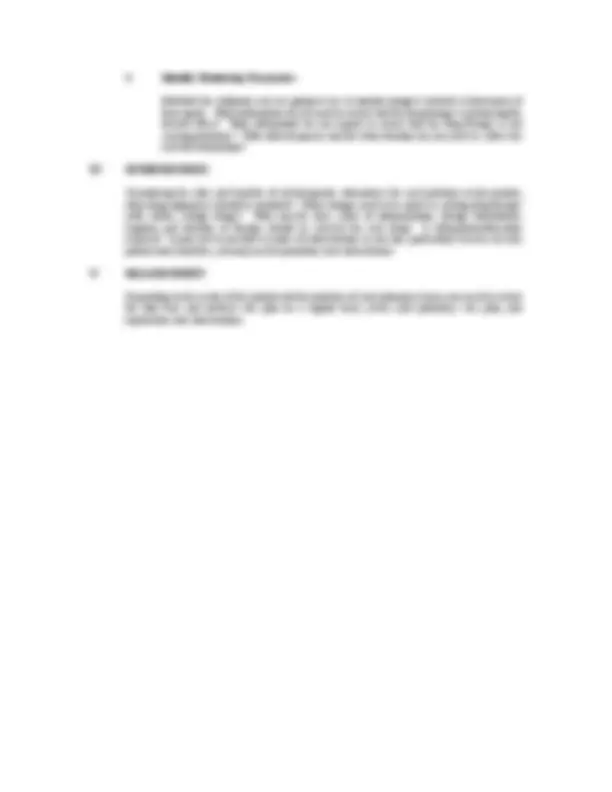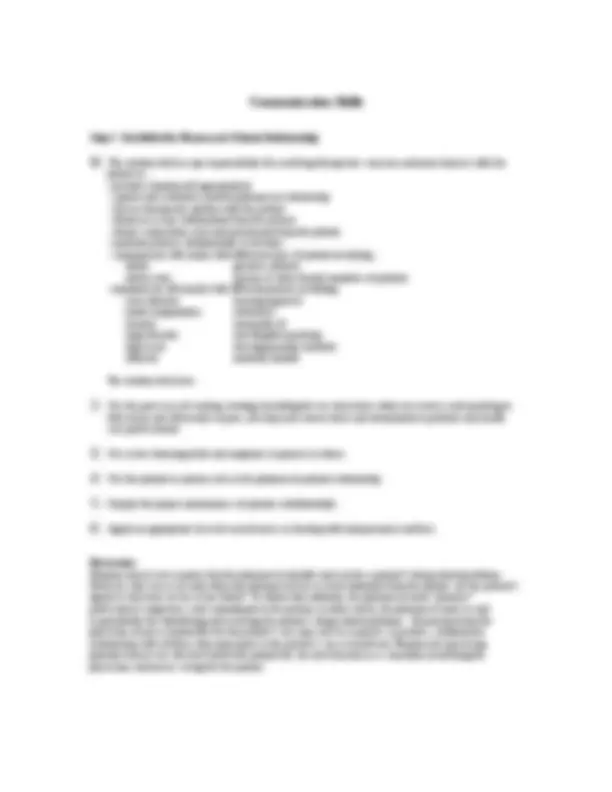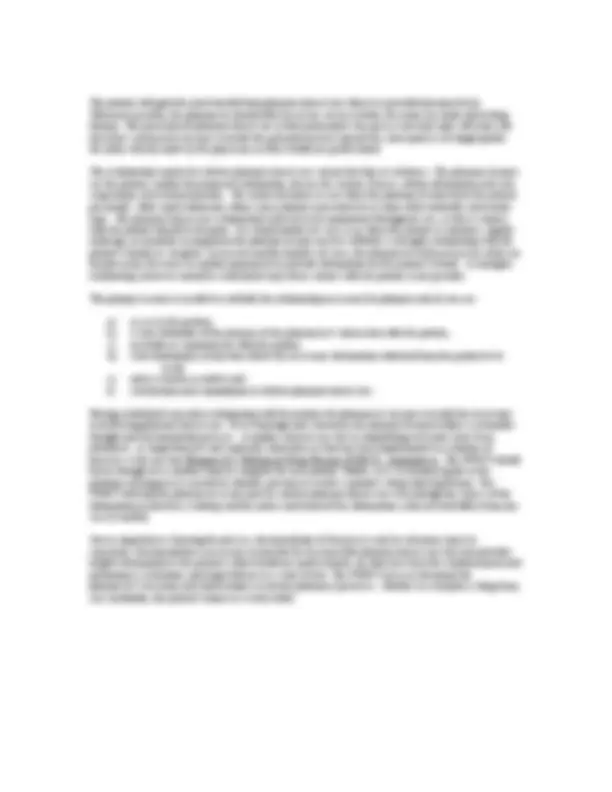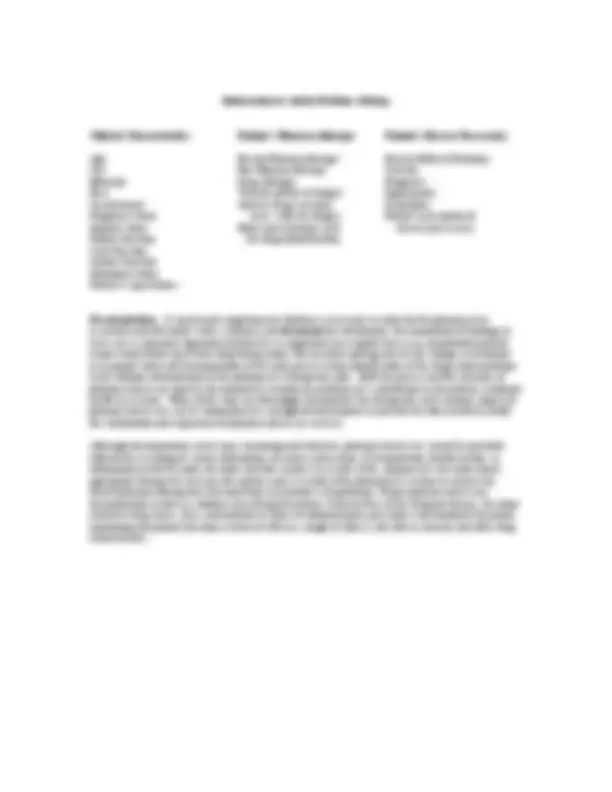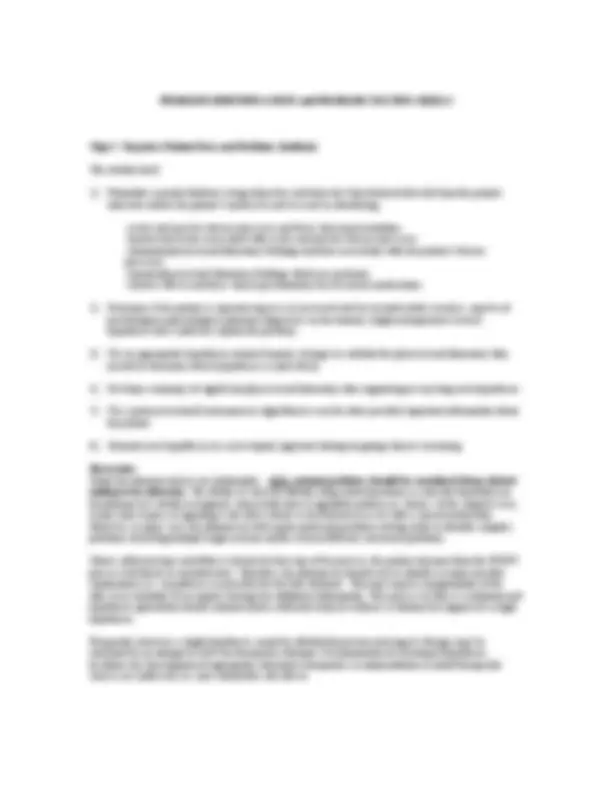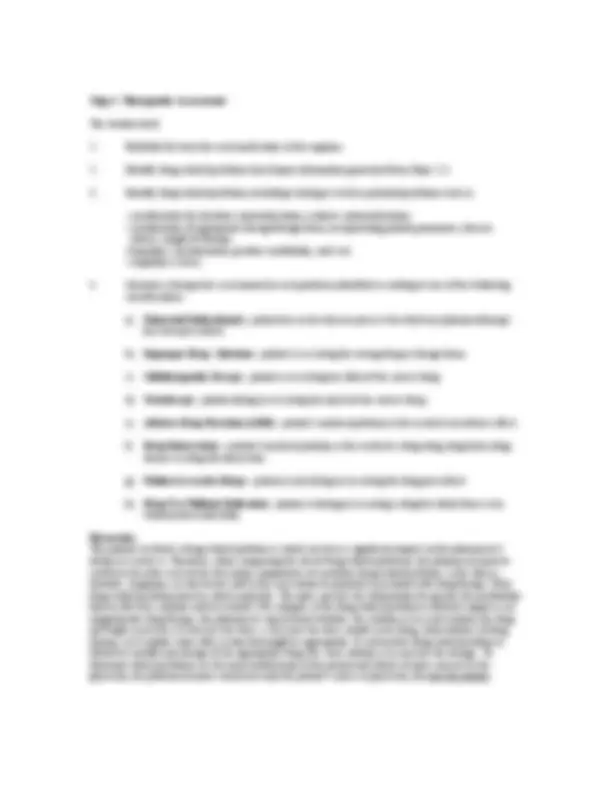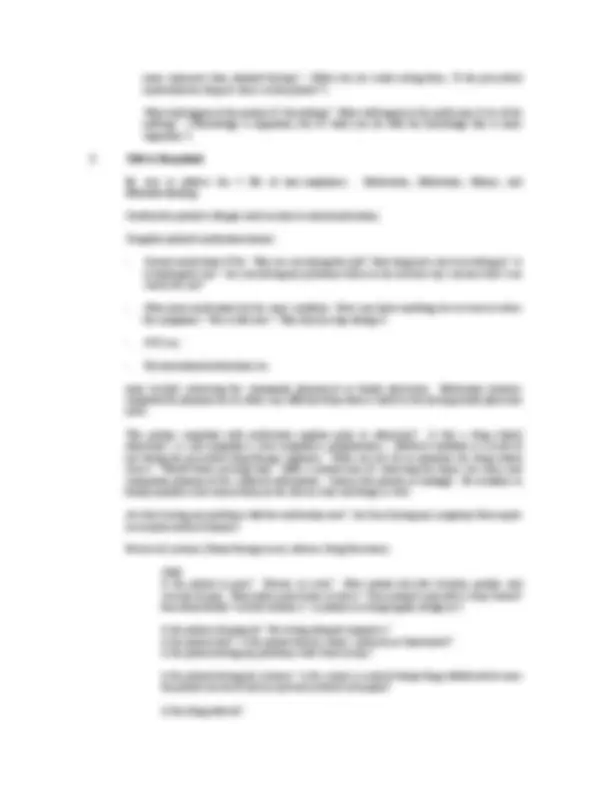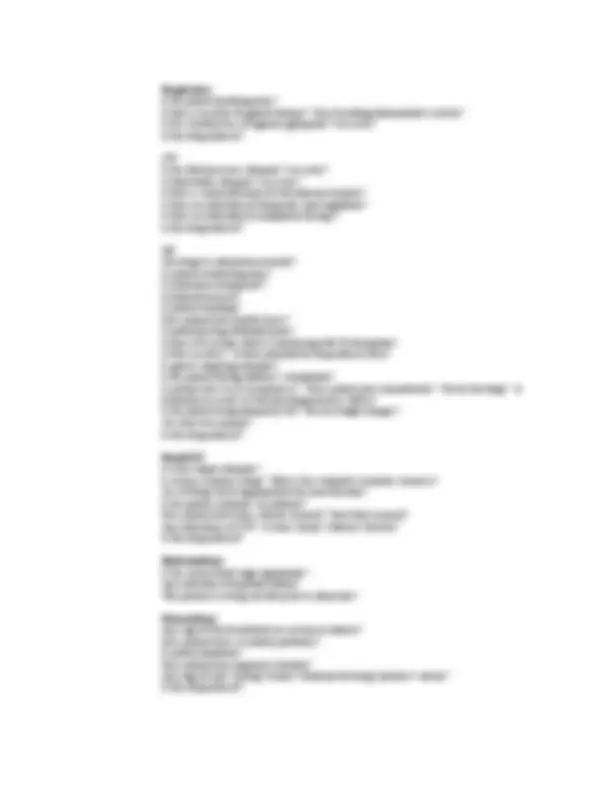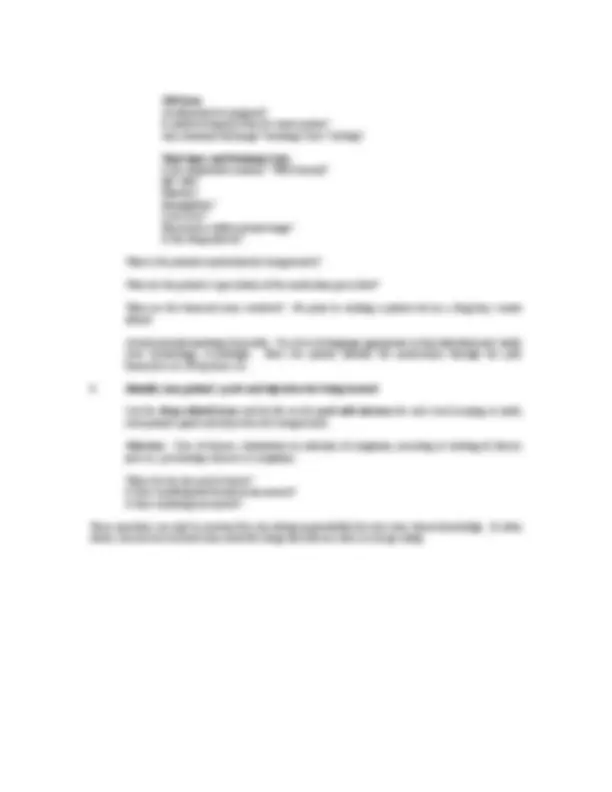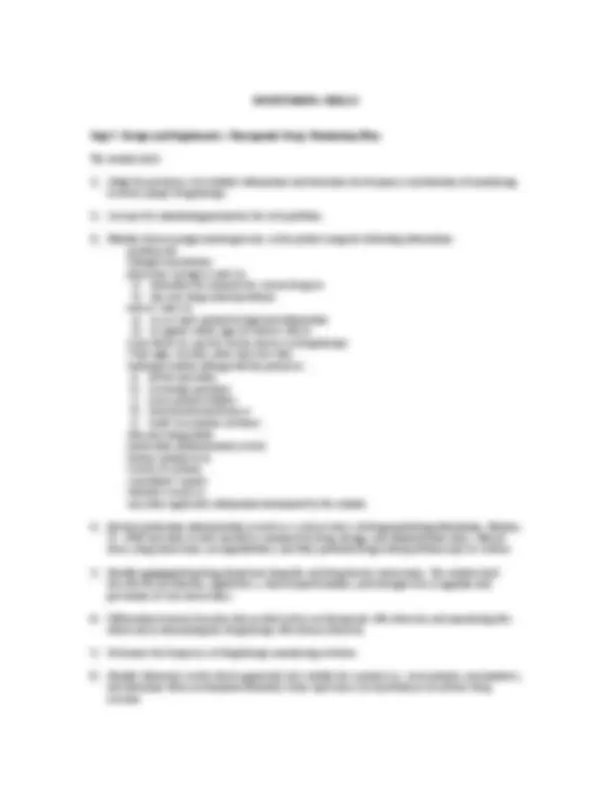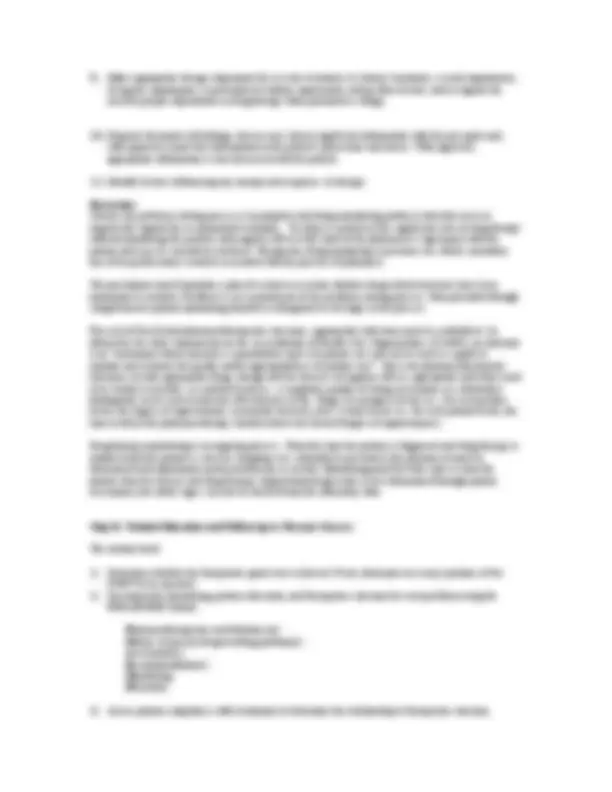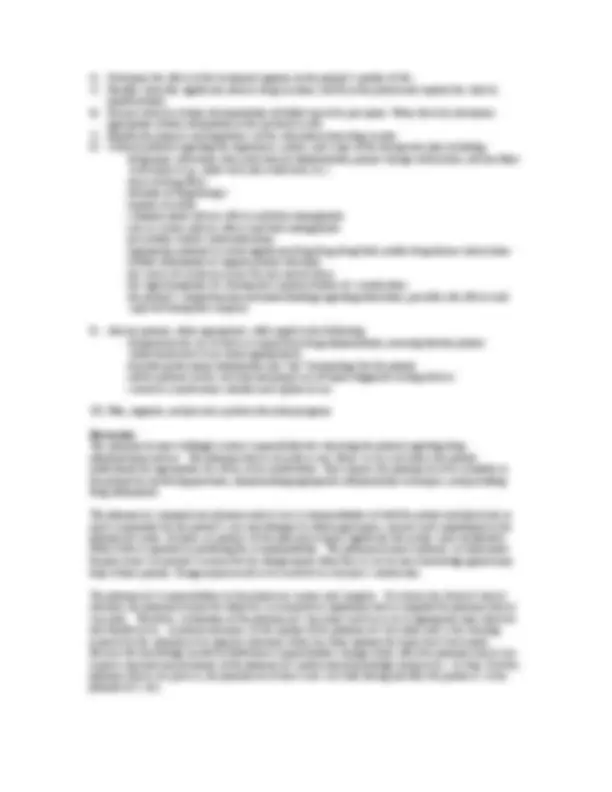Download PHARMACY CARE PLAN and more Study notes Pharmacy in PDF only on Docsity!
PHARMACY CARE PLAN
THE STEPS INVOLVED IN CREATING A PHARMACY CARE PLAN ARE:
- Establishment of a data base;
- Determination of the medical care plan;
- Development of a pharmacy care plan;
- Interventions;
- Reassessment. **I ESTABLISHMENT OF A DATA BASE
- Description of the Patient** Do these patient characteristics increase the risk of side effects from drugs, or affect drug absorption, distribution, metabolism or elimination?
- Age
- Sex
- Ethnicity
- Height: lead body weight calculations are dependent on height
- Weight: how does the patient's weight affect dosage calculations
- Lean Body Weight: use for calculating pharmacokinetic parameters and dosage recommendations Male: 50kg + [2.3 x (no. inches greater than 5ft)] Female: 45kg + [2.3 x (no. inches greater than 5ft)] 2. History of the Present Illness/Past Medical History Have the present medical problems been treated with drugs previously? What was the outcome? Is there anything in the history to suggest a contraindication to drug therapy or anything that would affect the drug's action or effectiveness? 3. Medication History What medications, routes of administration, doses and duration of treatment are presently being taken? Have the medications produced the desired therapeutic outcomes? Can these medications be contributing to some or all of the present medical problems? What organ systems (functions) are these medications affecting? Is there a history of success or failure with past drug therapy? Have past drugs adversely affected an organ system or function? What is the immunization history? This type of information may be obtained not only from the chart, but also from the patient interviews. 4. Allergies/Adverse Drug Reactions Have any allergic reactions occurred in the past? What is the nature and significance of past allergic reactions? Do potential allergies exist (drug, food, etc)? Is there evidence that the patient could not tolerate a medication in the past? Has the patient experienced side effects from any drugs before? If so, what drugs and what reactions? What was the treatment, if any? What was the outcome? 5. Smoking/Alcohol/Drug Abuse History
Can this patient's history affect drug absorption, distribution, metabolism or elimination, or can it contribute to the patient's medical problems?
6. Compliance History Do past therapeutic failures suggest a lack of adherence to drug regimens? What social history, living conditions and/or physical limitations might affect patient compliance? How reliable is the source of information? Is the patient responsible for his/her own drug taking. If not, who is? What is the patient's understanding of the instructions for taking the medication? 7. Physical Examination What abnormal signs and symptoms are being manifested that could affect drug therapy (eg. abnormal renal or hepatic function), or that will form the basis for outcome monitoring? (Use the review of systems in Appendix I as a systematic approach.) II DETERMINATION OF THE MEDICAL CARE PLAN What is the desired outcome for the primary problem in this patient (ie. remission, palliation, cure)? What are the desired outcomes for the other problems? Do any of these medical problems suggest an indication for drug therapy, or are they the result of drug therapy or could they affect the way a drug is absorbed, distributed, metabolized or eliminated? **III DEVELOPMENT OF THE PHARMACY CARE PLAN
- Assess the Pharmacotherapy** Relate all the drugs that have been ordered for the patient to the list of medical problems. Review the medication history to help identify drugs that the patient was on prior to admission and which the patient should continue to receive. Each drug already being administered and each new drug should be evaluated by asking questions such as:
- Is the use of this drug justified?
- Is there therapeutic duplication?
- Is this the drug of choice for this patient?
- What therapeutic alternatives are there?
- Is this therapy cost-effective?
- Has the dosage been adjusted for patient-specific changes? (ie. renal or liver impairment, age, weight, etc)
- What side effects are possible and are any of these more likely to occur in this patient? Is the patient currently experiencing any of these?
- Are there any clinically significant interactions possible? Management? 2. Identify Patient-Specific Drug Related Problems Drug related problems have been classified into eight categories (Strand et all):
- Lack of therapy for a drug/medical indication
- Wrong drug for the medical condition
- Too little of the correct drug prescribed
- Too much of the correct drug prescribed
- Medical condition caused by adverse drug reaction
- Medical condition caused by any type of interaction
- Medical condition caused by lack of drug prescribed
- Medical condition caused by inappropriate drug therapy (no valid indication
Communication Skills
Step 1: Establish the Pharmacist-Patient Relationship
1) The student shall accept responsibility for resolving therapeutic concerns and must interact with the
patient to :
- introduce him/herself appropriately
- explain and establish a patient-pharmacist relationship
- discuss therapeutic options with the patient
- obtain necessary information from the patient
- obtain cooperation, trust and permission from the patient
- maintain patient confidentiality at all times
- communicate efficiently with different types of patient including : adults geriatric patients adolescents parents or other family members of patients
- communicate efficiently with difficult patients including: over talkative hearing impaired multi-symptomatic inebriated anxious terminally ill angry/hostile non-English speaking depressed developmentally disabled illiterate mentally limited The student shall also:
2) Use the processes of reading, writing (including the use of pictures when necessary), and speaking to
effectively and efficiently acquire, develop and convey ideas and information to patients and health care professionals.
3) Use active listening skills and emphatic responses to others.
4) Use the patient-as-partner role in the pharmacist-patient relationship.
5) Display the proper maintenance of patient confidentiality.
6) Apply an appropriate level of assertiveness in dealing with interpersonal conflicts.
Discussion: Pharmaceutical care requires that the pharmacist identify and resolve a patient’s drug-related problems. However, that can occur only when the pharmacist has received authority from the patient (or the patient’s agent) to intervene on his or her behalf. To obtain that authority, the pharmacist must “promise” professional competence and commitment to the patient; in other words, the pharmacist must accept responsibility for identifying and resolving the patient’s drug-related problems. Permission from the physician or nurse responsible for the patient’s care may also be required. A positive, collaborative relationship with all those who participate in the patient’s care is beneficial. Pharmacists practicing pharmaceutical care directly benefit the patient but can also function as a consultant, benefiting the physicians and nurses caring for the patient.
The patient will gain the most benefit from pharmaceutical care when it is provided prospectively. Whenever possible, the pharmacist should offer his or her services before decisions are made about drug therapy. The provision of pharmaceutical care at that point makes the process not only more efficient, but also more constructive because it avoids the potential need to remedy the consequences of inappropriate decisions already made by the physician or other healthcare professional. The relationship required to deliver pharmaceutical care cannot develop at a distance. The pharmacist must see the patient, explain the proposed relationship, discuss the various choices, obtain information and seek cooperation, trust and permission. The initial encounter occurs when the pharmacist interviews the patient personally either upon admission, when a prescription is presented or at some other mutually-convenient time. The pharmaceutical care relationship will need to be maintained throughout care, so direct contact with the patient should be frequent. In a small number of cases (e.g. when the patient is comatose, legally underage, or mentally incompetent) the pharmacist may need to establish a surrogate relationship with the patient’s family or caregiver. In an even smaller number of cases, the pharmacist will need to rely solely on the physician, the nurse or another pharmacist to provide information on the patient’s behalf. A surrogate relationship, however should be established only when contact with the patient is not possible. The primary resources needed to establish the relationship necessary for pharmaceutical care are: a) access to the patient, b) a clear definition of the purpose of the pharmacist’s interaction with the patient, c) an ability to communicate with the patient, d) a documentation system that allows the necessary information obtained form the patient to be easily e) and accurately recorded, and f) a dedication and commitment to deliver pharmaceutical care. Having established a positive relationship with the patient, the pharmacist can proceed with the next steps in delivering pharmaceutical care. To be thorough and consistent, the pharmacist must follow a systematic thought-and-documentation process. A number of processes for accomplishing such tasks have been published. A comprehensive and explicitly stated process that has been implemented in a number of practices is the ten-step Pharmacist’s Workup of Drug Therapy (PWDT) - Appendix A The PWDT should not be thought of as another form to complete for each patient. Rather, it is a systematic guide to the problem-solving process needed to identify, prevent or resolve a patient’s drug related problems. The PWDT will help the pharmacist in any practice deliver pharmaceutical care even though the source of the information needed for a workup and the nature and detail of the information collected will differ from one case to another. Just as important as learning the process, documentation of the process and its outcomes must be consistent. Documentation is necessary to provide the best possible pharmaceutical care but also provides helpful information to the patient’s other healthcare professionals, an objective basis for reimbursement and performance evaluation, and legal defense in a court of law. The PWDT serves to document the pharmacist’s decisions and interventions in various pharmacy practices - whether in a hospital, a long-term- care institution, the patient’s home or a retail outlet.
- EKG - CAT scan or MRI
- X-ray - Pulmonary function studies
- Elicit a medication history from a patient during an interview using the following techniques:
- open ended questions - empathy
- facilitation - confrontation
- reflection - interpretation
- clarification - feelings
- Properly set and maintain the interview environment by utilizing privacy, distance, proper demeanor, pharmacist-patient relationship, transition and closing.
- Determine the following medication history information during the patient interview using a standard format:
- chief complaint (reason for seeking medical attention)
- active and inactive medical problems and patient’s understanding of the disease processes
- present prescription medications and patient’s knowledge of intended use, directions for appropriate drug administration, and possible adverse effects
- past prescription drug use
- OTC drug use
- social drug use (e.g. nicotine, ethanol and illegal drugs)
- allergies
- reason for starting/stopping medications
- satisfaction with drug therapy past/present
- Identify discrepancies in a patient profile or medication list and document corrections.
- Provide information gained from communication with the patient to the physician/nurse in a timely manner.
- Properly document all relevant findings in order to convey information to other health care professionals to ensure the best possible drug therapy for the patient.
- Plan, organize, and present a program to healthcare professionals. Discussion: Successful identification and resolution of drug related-problems depends on the ability of the pharmacist to collect and organize relevant information. Thus, the first task is to determine what information is necessary. Patient data can be grouped into three general categories: (a) patient complaints, signs or symptoms; (b) clinical characteristics of each illness or condition; and (c ) medications and social drug use. The source of information must be considered because it will differ in each patient’s case and in each practice setting. Common sources might include the patient, the patient’s caregiver or family, the medical record, the pharmacy profile, laboratory reports, physicians, nurses, other healthcare professionals, and technical staff. Having gathered the relevant patient information, the pharmacist then records and evaluates it in the context of his or her professional knowledge.
Information to Aid in Problem Solving Clinical Characteristics Patient’s Pharmacotherapy Patient’s Disease Process(es) Age Present Pharmacotherapy Present Medical Problems Sex Past Pharmacotherapy Severity Ethnicity Drug Allergies Prognoses Race Toxicity profile of drug(s) Impairments Social history Adverse drug reactions Disabilities Pregnancy status assoc. with the drug(s) Patient’s perception of Immune status Route and technique used disease process(es) Kidney function for drug administration Liver function Cardiac function Nutritional status Patient’s expectations Documentation: A current and comprehensive database is necessary in order for the pharmacist to accurately and efficiently collect, interpret, and document the information. Documentation of findings in each case is extremely important and must be accomplished on a regular basis (e.g., hospitalized patients require daily follow up of their drug therapy plan) This includes making note of any changes in treatment or in patient status and documentation of the entire process form identification of the drug-related problem to the ultimate determination of the pharmacist’s therapeutic plan. Both the process and the outcome of pharmaceutical care must be documented to evaluate the pharmacist’s contribution to the patients continued health or recovery. When all the steps are thoroughly documented, the therapeutic and economic impact of pharmaceutical care can be summarized in a straight forward manner to provide the data needed to justify the continuation and expansion of pharmaceutical care services. Although documentation can be time consuming and intensive, pharmaceutical care cannot be provided without the recording of certain information, decisions, and actions. Documentation should include: a) information needed to make decisions and take actions, b) records of the pharmacist’s decisions about appropriate therapy for each specific patient, and c) records of the pharmacist’s actions to achieve the desired pharmacotherapeutic outcome from each patient’s drug therapy. Proper pharmaceutical care documentation results in a database describing the patient; characteristics of the drug and disease; decisions related to drug choice, dose, and methods or routes of administration; procedures and standards for patient monitoring and patient outcomes n terms of efficacy, length of illness, side effects, toxicity and other drug related factors.
Step 4: Therapeutic Assessment The student shall:
- Establish the basis for each medication in the regimen.
- Identify drug-related problems based upon information generated from Steps 1- 3
- Identify drug-related problems including existing as well as potential problems such as:
- consideration for absolute contraindications, relative contraindications
- consideration of appropriate dosage/dosage form, incorporating patient parameters, disease state(s), length of therapy.
- formulary considerations, product availability, and cost
- compliance issues
- Generate a therapeutic assessment for each problem identified according to one of the following classifications: a) Untreated Indication(s) - patient has active disease process for which no pharmacotherapy has been prescribed. b) Improper Drug Selection - patient is receiving the wrong drug or dosage form. c) Subtherapeutic Dosage - patient is receiving too little of the correct drug. d) Overdosage - patient taking or receiving too much of the correct drug. e) Adverse Drug Reaction (ADR) - patient’s medical problem is the result of an adverse effect f) Drug Interactions - patient’s medical problem is the result of a drug-drug, drug-food, drug- disease or drug-lab interaction g) Failure to receive Drugs - patient is not taking or receiving the drug prescribed h) Drug Use Without Indication - patient is taking or receiving a drug for which there is no valid medical indication Discussion: The manner in which a drug-related problem is stated can have a significant impact on the pharmacist’s ability to resolve it. Therefore, when composing the list of drug related problems, the pharmacist must be careful to describe each of the two major components of a patients drug related problem: a) the illness, disorder, symptoms, or risk factors and b) the association or potential association with drug therapy. Each drug related problem must be stated explicitly. The more specific the information the greater the probability that an effective solution will be realized. For example, if the drug related problem is defined simply as an inappropriate drug therapy, the pharmacist cannot know whether the solution is to a) discontinue the drug and begin a new one, b) increase the dose, c) decrease the dose, d)add a new drug, e)discontinue all drug therapy, or f) initiate some other action that might be appropriate. If, instead the drug related problem is defined as insufficient dosage of the appropriate drug, the clear solution is to increase the dosage. To determine which problems are the most troublesome to the patient and which of most concern to the physician, the pharmacist must consult not only the patient’s nurse or physician, but also the patient.
Step 5: Rank the Patient’s Drug-Related Problems The student shall be able to:
- Prioritize the patient’s therapeutic and drug-related problems with regard to patient risk and overall clinical importance.
- Prioritize the patient’s drug-related problems with regard to chronological importance of pharmaceutical care action i.e. immediate problems requiring prompt intervention are ranked highest , and potential problems which may require simple monitoring are ranked lowest. Discussion: The pharmacist now ranks the patient’s drug-related problems according to the degree of risk that each problem confers. Risk is defined by the extent of danger to the patient and the rapidity with which the problem can harm the patient. Once the list of drug-related problems is ranked, the pharmacist must decide a) which problems may be resolved (or prevented) immediately, b) which problems can be resolved by the pharmacist and which require the help of someone else and ultimately, c) which problems the pharmacist will accept the responsibility to resolve. Once those decisions have been made, the pharmacist can determine which resources are necessary. When step 5 is completed, a documented comprehensive ranking of the patient’s drug related problems become available for the patient, other pharmacists, physicians, and nurses. In addition, the pharmacist now knows his or her own responsibilities as they relate to a specific patient and can proceed with resolving or preventing the patient’s actual or potential drug-related problems. Each problem to be resolved should be given a rank-order number, and the same number should be used throughout the problem-resolving process. Categorizing drug-related problems is the mechanism by which the pharmacist can prospectively identify, solve, prevent, quantify, predict and intervene. The future role of pharmacy is made more tangible, while emphasizing the fact that the patient (not the drug entity) is the principal focus of the pharmacist’s decision and actions. A basis for the development of the process by which the pharmacist can significantly contribute to the overall positive outcome for the patient is also established.
more expensive than standard therapy? (What you are really asking then, "Is the prescribed medication the drug of choice in this patient?") What will happen to the patient if I do nothing? What will happen to the profession if we all do nothing? ("Knowledge is important, but it's what you do with the knowledge that is more important.")
2. Talk to the patient Be sure to address the 4 M's of non-compliance: Medication, Motivation, Money, and Misunderstanding Confirm the patient's allergies and reaction to stated medications. Complete patient's medication history: - Current medications PTA: Why are you taking this pill? How long have you been taking it? Is it working for you? Are you having any problems with it or do you have any concerns that I can clarify for you? - Other prior medications for the same condition: Have you taken anything else to treat or reduce the symptoms? Was it effective? Why did you stop taking it? - OTC use. - Unconventional medication use. (may include contacting the community pharmacist or family physician) Medication histories completed by pharmacists are often very different from what is stated in the nursing and/or physician notes. Was patient compliant with medication regimen prior to admission? Is this a drug related admission? ie. non-compliance, over-compliance, polypharmacy. (Medical condition is a result of not taking the prescribed drug therapy regimen). What can you do to minimize the drug related issues? Would blister packing help? Make a mental note of contacting the home care nurse and community pharmacist for collateral information. Counsel the patient accordingly. Be available to family members and counsel them on the disease state and drugs as well. Are they having any problems with the medication now? Are they having any symptoms that require assessment and/or treatment? Review of systems (Unmet therapy need, Adverse Drug Reactions) CNS Is the patient in pain? Chronic or acute? Have patient describe location, quality, and severity of pain. What makes pain better or worse? Does patient's pain affect sleep? mood? functional ability? activity tolerance? Is patient receiving regular analgesics? Is the patient sleeping ok? Receiving adequate hypnotics? Is the patient alert? Is the patient drowsy, dizzy, confused, or disoriented? Is the patient having any problems with visual acuity? Is the patient having any seizures? Is the seizure a result of abrupt drug withdrawal because the patient ran out of med or med not restarted in hospital? Is this drug induced?
Respiratory Is the patient breathing okay? Is there a need for B-agonist therapy? Does breathing limit patient's activity? Is the schedule for a B-agonist appropriate? excessive? Is this drug induced? CV Is the blood pressure adequate? excessive? Is fluid intake adequate? excessive? Is there a contraindication of subcutaneous heparin? Is there an indication of therapeutic anticoagulation? Is there an indication for antiplatelet therapy? Is this drug induced? GI Can drugs be administered orally? Is patient swallowing okay? Is patient pocketing meds? Is patient nauseous? Is patient vomiting? Does patient have mouth ulcers? Is patient having abdominal pain? Is there NG suction which is interfering with GI absorption? Is there an ileus? Is there potential for drug induced ileus? Is gastric emptying adequate? Is the patient having diarrhea? constipation? Is patient have fecal incontinence? Does patient have hemorrhoids? Rectal bleeding? Is treatment necessary or will non-drug measures suffice? Is the patient being adequately fed? Recent weight changes? Are liver tests normal? Is this drug induced? Renal/GU Is urine output adequate? Is serum creatinine rising? What is the estimated creatinine clearance? Are all drugs dosed appropriately for renal function? Is the patient continent? incontinent? Does patient have foley catheter inserted? Date foley inserted? Any indications of UTI? Is urine cloudy? odorous? dysuria? Is this drug induced? Endocrinology Is the serum blood sugar appropriate? Any indication of hypothyroidism? Was patient receiving steroids prior to admission? Dermatology Any sign of skin breakdown on sacrum or buttock? Does patient have circulatory problems? Is patient immobile? Does patient have impaired sensation? Any sign of rash? itching? lesions? abnormal bruising? jaundice? edema? Is this drug induced?
THERAPEUTIC DECISION-MAKING SKILLS
Step 6: Establish a Desired Pharmacotherapeutic Outcome for Each Drug Related Problem The student shall:
- Define and/or demonstrate efficacy outcome measures for each therapeutic or drug-related problem.
- Define specific goals of pharmaceutical care for each drug related problem with emphasis on compliance issues including patient education and cost of therapy. Discussion: The physician, along with input from the patient, generally determines the clinical outcome expected from the therapy. Typically the intent is to a) cure a disease, b) alleviate or eliminate the symptoms and signs of the disease, c) arrest or slow a disease process or d) prevent a disease or its symptoms. However, since these clinical outcomes relate to most aspects of health care (medicine, nursing, etc.) and are not in themselves always measurable, the pharmacist must define specific pharmacotherapeutic outcomes based upon each patient’s unique clinical presentation and personal preference. For example, the goal of therapy may be defined as - (Problem #1) Hypertension: sitting blood pressure of < 140/90 and a standing blood pressure which is not < 130/80; (Problem 2) Diabetes Mellitus, Type II: fasting blood glucose of< 160 mg/dl. In defining the effectiveness of pharmacotherapy, qualitative and directional terms such as “increase”, “decrease” or “improve” are seldom useful. Instead, very specific, quantitative measures should be used whenever possible because they help to establish endpoints against which to monitor the patient’s progress and to provide the information needed to evaluate the quality of pharmaceutical care provide by the pharmacist.
Step 7: Determine the Rational Pharmacotherapeutic Alternatives
Given a therapeutic problem, the student shall:
- Identify the pharmacokinetic and pharmacodynamic factors which differentiate potential alternative drug therapies.
- List acceptable therapeutic alternatives for each drug related problem.
- Justify all acceptable therapeutic alternatives including the risk versus benefit of each, emphasizing efficacy and safety issues. This includes appropriate nonpharmacologic measures as well. Discussion: Listing all rational pharmacotherapeutic alternatives for each drug related problem ensures that the benefits and risks of each intervention have been carefully considered. Furthermore, it aids both the physician and pharmacist in their evaluation of therapeutic goals and will be essential if the initial drug regime is ineffective. This deliberation which also includes a choice of no drug therapy, is very different from the concept that only one drug of choice exists for each medical diagnosis. The two variables that place a drug on the pharmacist’s list of rational alternatives are:
- the probability that the drug will resolve or prevent the patient’s drug-related problem, and
- the drug’s safety in a specific patient. A number of variables will contribute to prevent an alternative from being selected as the “best” solution. They include:
potential allergies or toxicities, documentation of the drug’s previous ineffectiveness, the lack of appropriate monitoring services necessary for safe administration, the patient’s preference for a particular formulation, and high cost. Drug choices are facilitated when rational alternatives are listed in a consistent format. One useful format is tabulation according to distinguishing characteristics which might include, for example, a) different pharmacokinetic properties, b) different dosage forms of the same drug (such as patches versus tablets, or sustained-release versus rapid-release tablets), or c) different pharmacologic or biologic activities of drugs with similar indications. The preparation of a comprehensive list of rational alternatives requires the pharmacist’s access to drug information references, medical literature resources, other colleagues and, in some cases, pharmacotherapeutic specialists. Step 8: Select and Individualize the Therapeutic Regimen The student shall:
- Reassess all significant patient characteristics relevant to patient-specific drug selection.
- Reassess all patient-specific parameters which may increase the risk of an adverse drug reaction(ADR)
- Reaffirm problem-specific and overall outcome goals
- Use medical knowledge base, mathematical competence, critical thinking abilities, and consideration of patient preferences and abilities to formulate a therapeutic plane for each problem
- Select and justify the most appropriate treatment regimen for the patient, including non-drug treatments which may supplant a drug.
- Select and/or calculate an individualized dosage regimen using a) individual patient data and/or b) group data from the clinical literature.
- Effectively communicate the treatment regiment to the preceptor, other caregivers, and the patient. Discussion: Step 8 is intended to ensure that the patient receives the most appropriate solution for each drug-related problem. The pharmacist’s recommendation should incorporate the following in order of priority:
- therapeutic efficacy;
- safety;
- comfort, convenience, and adherence to the therapeutic regimen; and
- cost considerations. Having considered all alternatives, a complete pharmacotherapeutic recommendation to resolve (or prevent) each drug-related problem is formulated including the specific medication and its formulation, the individually calculated dosage (i.e., dosage, frequency, and duration), and any special instructions to the patient. Several decisions essential to this step will be made most efficiently and effectively when the patient is consulted. This may avert potential future problems, such as failure to comply with therapeutic or monitoring directions. Various methods have been developed to individualize pharmacotherapeutic regimens prospectively and cost efficiently. For example, computer software may be used to estimate patient-specific dosage requirements using individualized estimates of the patient’s renal and hepatic function and other biologic and physiologic factors known to alter drug-dosing requirements. However, pharmacists must also possess a thorough understanding of the theoretical and practical limitations of these programs to ensure appropriate recommendations.
- Make appropriate dosage adjustment for a) acute treatment, b) chronic treatment, c) renal impairment, d) hepatic impairment, e) perfusion/circulatory impairment, and g) other factors, and recognize the need for proper adjustments in drug therapy when parameters change.
- Properly document all findings, discuss any clinical significant information with the preceptor and, with approval, report this information to the patient’s physicians and nurses. With approval, appropriate information is also discussed with the patient.
- Identify factors influencing any unexpected response to therapy. Discussion: Clearly, the problem-solving process is incomplete until drug monitoring produces data that serve to empirically support the recommended solutions. To subject a patient to the significant risks of drug therapy without monitoring the positive and negative effects falls short of the pharmacist’s agreement with the patient and may be considered unethical. Therapeutic-drug monitoring is personal care which constitutes one of the professional rewards associated with the practice of pharmacy. The practitioner must formulate a plan of action to ascertain whether drug-related toxicities have been minimized or avoided. Feedback is an essential part of the problem-solving process. Data provided through comprehensive patient monitoring should be reintegrated at all stages in the process. For each of the desired pharmacotherapeutic outcomes, appropriate indicators must be established. As defined by the Joint Commission on the Accreditation of Health-Care Organisations (JCAHO), an indicator is an “instrument which measures a quantifiable aspect of patient care and can be used as a guide to monitor and evaluate the quality and/or appropriateness of patient care” Since our pharmacotherapeutic outcomes include appropriate drugs, dosage and the absence of negative effects, appropriate indicators need to be written to include a) a patient factor(i.e., a symptom, quality of living assessment, or a laboratory finding that can be used to measure effectiveness of the drug); b) a progress factor (i.e., for each patient factor, the degree of improvement reasonably desired); and c) a time factor (i.e. for each patient factor, the time in which the pharmacotherapy should achieve the desired degree of improvement.) Drug therapy monitoring is an ongoing process. From the time the patient is diagnosed and drug therapy is initiated until the patient is cured or symptoms are controlled or prevented, the pharmacist must be determined and adjustments made periodically as needed. Monitoring must first take into account the patient, then the disease and drug therapy. Improvement/regression is best determined through patient assessment, but subtle signs can also be derived form the laboratory data. Step 10: Patient Education and Follow-up to Measure Success The student shall:
- Determine whether the therapeutic goals were achieved. If not, determine necessary portions of the PWDT to be repeated
- Document the monitoring, patient education, and therapeutic outcome for each problem using the P.H.A.R.M.E. format: P harmacotherapeutic and Problem list: H istory of present drug use/drug problem(s): A ssessment(s): R ecommendation(s): M onitoring: E ducation:
- Assess patient compliance with treatments to determine the relationship to therapeutic outcome.
- Determine the effect of the treatment regimen on the patient’s quality of life.
- Identify clinically significant adverse drug reactions (ADR) in the patient and explain the clinical manifestations.
- Present verbal or written documentation of follow-up to the preceptor. When directed, document appropriate written information in the medical record.
- Explain the purpose and importance of the education/counseling session.
- Counsel patients regarding the importance, nature, and scope of the therapeutic plan including:
- drug name, indication, dose and route of administration, proper storage instructions, and ancillary instructions (e.g., shake well, take with food, etc.)
- onset of drug effect
- duration of drug therapy
- number of refills
- common minor adverse effects and their management
- rare or serious adverse effects and their management
- precautions and/or contraindications
- appropriate methods to avoid significant drug-drug, drug-food, and/or drug-disease interactions
- written information to support patient education
- the course of action necessary for any missed doses
- the signs/symptoms of a therapeutic response/failure of a medication
- the patient’s comprehension and understanding regarding indications, possible side effects and expected therapeutic response
- educate patients, when appropriate, with regard to the following:
- demonstrate the use of devices required for drug administration, ensuring that the patient understands how to use them appropriately
- translate professional information into “lay” terminology for the patient
- advise patients on the selection and proper use of home diagnostic testing devices
- construct a medication calendar and explain its use
- Plan, organize, and present a patient education program Discussion: The pharmacist must willingly assume responsibility for educating the patient regarding drug administration and use. The pharmaceutical care plan is not likely to succeed unless the patient understands the appropriate use of his or her medications. This requires the pharmacist to be available to the patient for answering questions, demonstrating appropriate administration techniques, and providing drug information. The pharmacist communicates pharmaceutical care recommendations to both the patient and physician or nurse responsible for the patient’s care and attempts to obtain agreement, consent, and commitment to the pharmacist’s plan. At times, acceptance of the plan may require significant discussion and considerable effort will be expended in justifying the recommendation The pharmacist must endeavor to understand the physician’s or patient’s reasons for the disagreement when they occur because knowledge gained may help a future patient. Disagreement needs to be resolved to everyone’s satisfaction. The pharmacist’s responsibilities to the patient are serious and complex. To achieve the desired clinical outcome, the pharmacist must do whatever is reasonable to implement and accomplish the pharmaceutical care plan. Therefore, evaluations of the pharmacist’s decisions need to occur at appropriate time intervals and should assess a) patient outcomes, b) the quality of the pharmacist’s decisions and c) the learning required by the pharmacist to improve outcomes when less-than-optimal decisions have been made. Because the knowledge needed to fulfill those responsibilities changes daily, effective pharmaceutical care requires repeated measurements of the pharmacist’s professional knowledge and practice. In Step 10 of the pharmaceutical care process, the pharmacist reviews each case both during and after the patient is in the pharmacist’s care.

